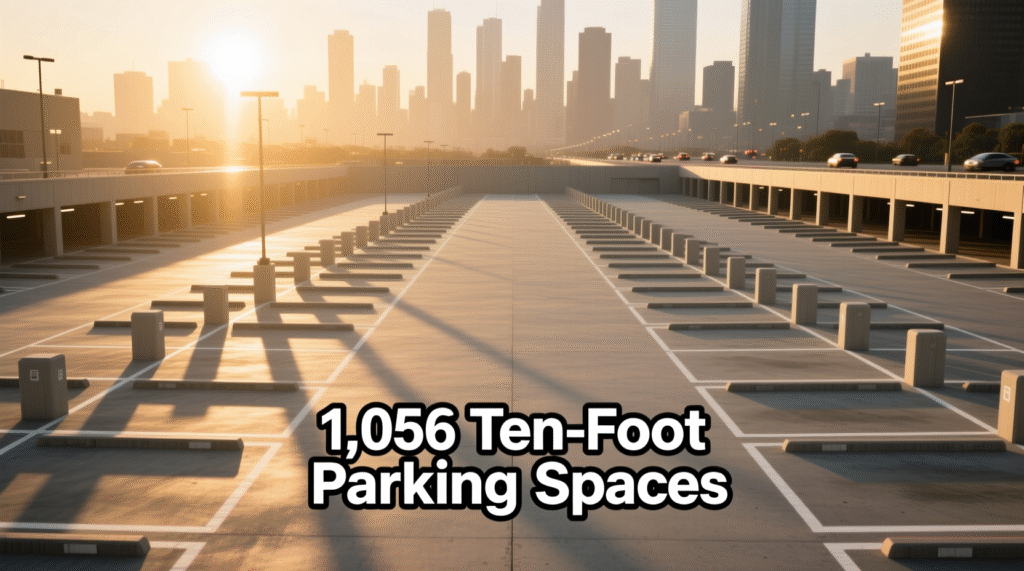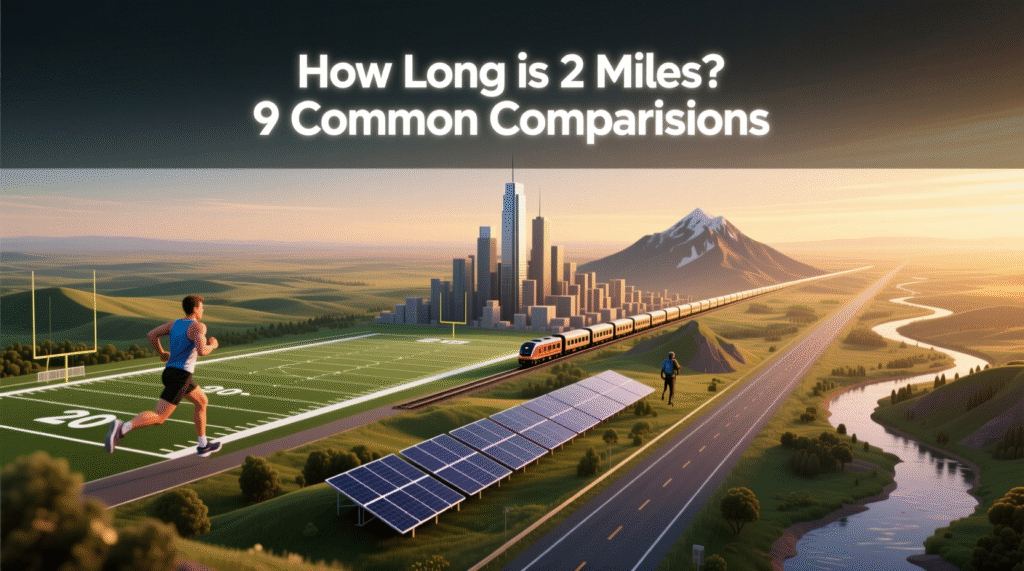Picture this: you’re standing at your front door, and someone tells you that your destination is “just 2 miles away.” But what does that really mean? Is it a quick stroll or a lengthy trek? Two miles might sound like a simple measurement, but it’s one of those distances that can feel dramatically different depending on whether you’re walking, running, driving, or cycling. This distance has played a crucial role throughout human history – from the Roman mile that gave us our modern measurement to the famous “last mile” problem in logistics and telecommunications.
Understanding 2 miles isn’t just about numbers on a map. It’s about grasping a distance that appears everywhere in our daily lives: the distance between subway stops in major cities, the typical radius of a neighborhood, or the length of a moderate hiking trail. Whether you’re planning a morning jog, estimating travel time, or trying to decide if something is within walking distance, having a solid grasp of what 2 miles looks like in the real world can be incredibly useful.
How Long is 2 Miles?
Two miles equals exactly 10,560 feet or 3,218 meters. To put this in perspective, it’s roughly the distance you’d cover walking briskly for about 30-40 minutes, jogging for 15-20 minutes, or driving for 3-4 minutes in city traffic. This measurement sits in that interesting sweet spot – not quite a neighborhood stroll, but not an epic journey either. It’s the kind of distance that makes you pause and consider your transportation options, whether that’s lacing up your walking shoes, grabbing your bike, or jumping in the car.
Now, let’s explore nine familiar comparisons that will help you visualize exactly what 2 miles looks like in the real world.
1. 35 City Blocks (Manhattan Grid System)

Manhattan’s famous grid system provides one of the most reliable ways to visualize 2 miles. In the heart of New York City, 20 north-south blocks equal approximately one mile, making 40 blocks roughly equivalent to 2 miles. However, when we factor in the slightly longer east-west blocks, about 35 blocks gives us a more accurate representation of this distance.
This urban measurement system has shaped how millions of people think about distance. The Manhattan grid, established in 1811, was designed with practicality in mind – each avenue runs north to south, while numbered streets run east to west. The consistency of this system means that whether you’re walking from 14th Street to 54th Street, you’re covering almost exactly 2 miles.
What makes this comparison particularly valuable is its real-world application. Many major cities have adopted similar grid systems, and even those that haven’t often use city blocks as an informal distance measure. Understanding that 2 miles equals roughly 35 Manhattan-style blocks can help you navigate unfamiliar urban areas and better estimate walking times.
Fascinating fact: The Manhattan grid system was so precisely planned that it actually ignored the natural topography of the island. The commissioners deliberately chose to create a uniform system rather than work around hills and natural features, fundamentally reshaping how we think about urban distance measurement.
2. 32 Football Fields End to End

American football fields offer another excellent reference point for visualizing 2 miles. Each NFL field measures 120 yards from goal line to goal line (including the end zones), which equals 360 feet. Lined up end to end, approximately 32 football fields would stretch for 2 miles.
This comparison resonates particularly well because football fields represent a standardized measurement that millions of Americans can instantly visualize. Whether you’ve played on one, watched games from the stands, or seen countless televised matches, you likely have a strong mental image of a football field’s size.
The standardization of football field dimensions has interesting practical applications beyond sports. Emergency services often use football field lengths as reference points when describing accident scenes or search areas. Construction crews and event planners frequently use this measurement when discussing large-scale projects or venue layouts.
Remarkable insight: The 100-yard football field length wasn’t chosen arbitrarily. It was actually based on the length of early rugby fields, which were designed to fit within the confines of available land at universities and colleges. This seemingly random measurement has now become one of America’s most recognizable distance standards.
3. 4 Laps Around a Standard Running Track

Most outdoor running tracks at high schools, colleges, and athletic facilities follow international standards, measuring exactly 400 meters (approximately 437 yards) around the innermost lane. This means that 4 complete laps around the track will take you roughly 1,600 meters, which is just slightly short of a mile. To cover exactly 2 miles, you’d need to complete about 8 laps around a standard track.
However, for practical visualization purposes, imagining 4 laps helps people understand the scope of 2 miles, especially those familiar with track and field. Many fitness enthusiasts know the feeling of completing a mile on the track, so doubling that mental reference provides an excellent gauge for 2 miles.
Running tracks serve as perfect measuring tools because of their precision and universal standardization. The International Association of Athletics Federations (IAAF) maintains strict guidelines ensuring that tracks worldwide provide consistent measurements. This standardization means that whether you’re in Tokyo, London, or your local high school, the track will be virtually identical in size.
Athletic trivia: The 400-meter track distance was chosen because it allows for the classic mile run (4 laps plus 9 meters) to finish at the same point where it started. This design consideration has made the 400-meter track the global standard, turning it into one of the most reliable distance references available to the general public.
4. The Length of 22 Boeing 747 Jumbo Jets

Commercial aviation provides some of the most impressive size comparisons available. A Boeing 747-400, one of the most recognizable aircraft in the world, measures approximately 231 feet from nose to tail. Placing 22 of these massive jets in a straight line, wingtip to wingtip, would create a distance very close to 2 miles.
This comparison is particularly striking because most people have either flown in a 747 or seen one at an airport, making it easy to appreciate the enormous scale involved. When you consider that each of these aircraft can carry up to 660 passengers and weighs over 400,000 pounds when fully loaded, visualizing 22 of them lined up creates a truly impressive mental image.
The Boeing 747 revolutionized air travel when it was introduced in 1970, earning the nickname “Queen of the Skies.” Its distinctive hump-shaped upper deck and four-engine design made it instantly recognizable worldwide. For decades, it was the largest passenger aircraft in regular service, making it an ideal reference point for large-scale measurements.
Aviation marvel: The wingspan of a Boeing 747 is actually wider than the Wright brothers’ first powered flight was long. Orville Wright’s historic 12-second flight in 1903 covered just 120 feet – less than half the width of a single 747’s wings, which span 211 feet.
5. 2,000 Average Adult Steps

For fitness enthusiasts and health-conscious individuals, counting steps has become a daily routine. The average adult has a stride length of approximately 2.5 feet, which means it takes about 2,000 steps to cover one mile. Therefore, walking 2 miles requires roughly 4,000 steps – but we’ll use 2,000 steps as our comparison point to represent half that distance for easier visualization.
This measurement varies significantly based on height, leg length, and walking pace. Taller individuals typically have longer strides, while shorter people take more steps to cover the same distance. A person who is 6 feet tall might cover 2 miles in 3,800 steps, while someone who is 5’2″ might need 4,400 steps for the same distance.
The popularity of fitness trackers and smartphone step counters has made step counting incredibly common. Most health organizations, including the American Heart Association, recommend 10,000 steps per day for optimal health – which equals approximately 5 miles of walking. Understanding that 2 miles represents about 4,000 steps helps put daily activity goals into perspective.
Health insight: The famous 10,000-step recommendation actually originated from a 1960s Japanese marketing campaign for a pedometer called “manpo-kei,” which translates to “10,000 steps meter.” While this number was initially chosen for marketing reasons rather than scientific research, subsequent studies have shown that it does represent a beneficial daily activity level for most adults.
6. 1,056 Ten-Foot Parking Spaces

Standard parking spaces in the United States typically measure 9 to 10 feet in width and 18 to 20 feet in length. Using the common 10-foot width measurement, you would need to line up 1,056 parking spaces end to end to reach 2 miles. This comparison works particularly well because virtually everyone has experience with parking spaces and can easily visualize their size.
Parking space dimensions are regulated by local building codes and the Americans with Disabilities Act (ADA), which ensures some consistency across different locations. However, these measurements can vary significantly – compact spaces might be only 8 feet wide, while luxury shopping centers might offer spaces up to 12 feet wide for customer convenience.
The standardization of parking spaces has had a profound impact on urban planning and architecture. Shopping centers, office buildings, and residential complexes are often designed around parking requirements, with the number and size of spaces influencing the entire layout of developments.
Urban planning fact: The amount of land dedicated to parking in American cities is staggering. Some studies suggest that parking takes up as much as 30% of urban land area in major cities. In Los Angeles, there are an estimated 18.6 million parking spaces – roughly 3.3 spaces for every resident of the entire metropolitan area.
7. 40 Average Suburban House Lots

Typical suburban residential lots in American developments range from 0.25 to 0.5 acres, with many falling around 0.3 acres. A 0.3-acre lot measures approximately 130 feet by 100 feet. If we line up 40 of these lots along their 130-foot dimension, we get very close to 2 miles (5,200 feet compared to the actual 10,560 feet in 2 miles).
Suburban lot sizes have evolved significantly over the past century. In the post-World War II building boom, lots were often much larger, sometimes exceeding one acre. Modern developments tend toward smaller lots to maximize the number of homes that can be built in a given area, reflecting both land costs and changing lifestyle preferences.
The size of residential lots directly impacts property values, privacy levels, and maintenance requirements. Larger lots offer more space for gardens, pools, and outdoor activities, but they also require more upkeep and typically come with higher property taxes based on the increased land value.
Real estate insight: The average American home sits on a lot that’s dramatically smaller than homes built 50 years ago. In 1978, the median lot size for new homes was 0.48 acres. By 2018, that had shrunk to just 0.23 acres – a reduction of more than 50%. This trend reflects both rising land costs and changing buyer preferences toward lower-maintenance properties.
8. 105 School Buses Lined Up

The classic American school bus – that familiar yellow vehicle that transported millions of children to school – provides an excellent reference for distance measurement. A standard full-size school bus measures approximately 35 to 40 feet in length. Using the average length of 38 feet, you would need to line up about 105 school buses to reach 2 miles.
School buses are designed to very specific safety standards established by the National Highway Traffic Safety Administration (NHTSA). These regulations ensure that school buses across the country share similar dimensions, making them reliable reference points for distance estimation. The familiar yellow color, mandated by federal law since 1939, makes school buses one of the most universally recognizable vehicles in America.
Beyond their role in education, school buses represent one of the safest forms of ground transportation available. Despite their size and the precious cargo they carry, school buses have an excellent safety record, with students being 70 times more likely to arrive at school safely when riding the bus compared to traveling by car.
Transportation fact: American school buses collectively travel more than 6 billion miles each year, transporting approximately 26 million students daily. If all the school buses in America were lined up end to end, they would stretch for roughly 35,000 miles – enough to circle the Earth 1.4 times at the equator.
9. 6 Large City Blocks in Chicago

Chicago’s downtown grid system offers another urban comparison for visualizing 2 miles. The Windy City’s blocks are notably larger than Manhattan’s, with approximately 8 blocks per mile running north-south. This means that 6 Chicago blocks, when measured along the longer dimension, comes very close to representing 2 miles.
Chicago’s grid system, established after the Great Chicago Fire of 1871, was designed with wider blocks than many older cities. This planning decision reflected the city’s rapid growth and the opportunity to rebuild with more spacious urban design. The larger block size makes Chicago’s downtown feel more open and less cramped than cities with smaller, more frequent intersections.
The Chicago grid system has influenced urban planning across the Midwest, with many cities adopting similar large-block designs. This approach creates longer sight lines, reduces the number of traffic intersections, and allows for larger building footprints – all factors that contribute to the distinctive character of Midwestern cities.
Architectural legacy: The rebuilding of Chicago after the 1871 fire led to numerous innovations in urban planning and architecture, including the development of the modern skyscraper. The wider streets and larger blocks in the new Chicago grid system provided the space necessary for these tall buildings and the infrastructure to support them.
Real-World Applications and Practical Measurement Tips
Understanding what 2 miles looks like has numerous practical applications in daily life. When house hunting, knowing that 2 miles typically represents a 5-8 minute drive in suburban areas helps evaluate commute times to work, schools, or shopping centers. For fitness enthusiasts, recognizing that 2 miles equals about a 30-40 minute walk makes it easier to plan exercise routines and set realistic goals.
For those without measuring tools, here are some practical tips for estimating 2 miles:
Using your walking pace: Time yourself walking for 10 minutes at a comfortable pace, then multiply that distance by 3 or 4 to approximate 2 miles. Most people walk between 3-4 miles per hour, so 30-40 minutes of walking typically covers 2 miles.
Vehicle odometer method: Use your car’s odometer to measure 2 miles from a starting point, noting landmarks along the way. This creates a personal reference route that you can use for future distance estimations in your area.
Digital mapping: Smartphone map applications often display distance scales. You can use these to identify 2-mile distances in your neighborhood, creating familiar reference points for future use.
Public transportation: Many bus routes and subway systems have stops spaced at regular intervals. Research the typical distance between stops in your city – this knowledge can help you estimate longer distances based on the number of stops.
Conclusion
Mastering the visualization of 2 miles opens up a world of practical benefits in daily life. Whether you’re planning a morning jog, evaluating the walkability of a new neighborhood, or trying to determine if a destination is worth the drive versus the walk, having solid reference points for this distance makes decision-making much easier.
From the 35 Manhattan city blocks that define urban distance to the 32 football fields that represent suburban space, these comparisons provide you with a toolkit for understanding distance in various contexts. The next time someone mentions that something is “just 2 miles away,” you’ll have the mental framework to instantly understand whether that’s a pleasant stroll or a more significant journey.
Take on this challenge: look around your current location and see how many of these 2-mile reference points you can identify. Can you spot a route that would equal 32 football fields? Is there a straight road that might accommodate 105 school buses? By connecting these measurements to your immediate environment, you’ll develop an intuitive understanding of distance that will serve you well in countless future situations.
Remember, distance is more than just numbers – it’s about understanding the world around you and making informed decisions about how you navigate through it. With these nine comparisons in your mental toolkit, 2 miles will never again be just an abstract measurement, but a concrete, visualizable distance that you can apply to enhance your daily life.

James Harrington is a writer known for his compelling storytelling and diverse themes. His work blends creativity with thought-provoking ideas, captivating readers across genres. Through his website, DimensionsGo.com, he shares his latest projects, insights, and literary reflections, building a global community of readers and writers.



